How to Survive Children in the Woods: Tips from a Mommy Non-Blogger
Because finding solace in the outdoors is more important now than ever... and chances are, your kids have to come with you.
Hi there. I thought I’d take some time to write about the outdoors—something that has consistently brought me peace and even, mercifully, helped me forget both my perpetual to-do list and the fact that I live in a dysfunctional society. My family has been to ten national parks this summer, and we’ve seen all types of people: Trump supporters, Biden supporters, Kanye West supporters, and everything outside and in between. It seems that nature really does transcend politics. “But wait, Erika,” you might say, “going out into nature is not that easy now that there are children in the mix! More anxiety-inducing than awaiting election results, more daunting than spending a night in a cemetery alone, is spending a night in the wilderness with kids!” Never fear. Here’s my guide to surviving children in the woods: mistakes to avoid, tricks for hiking, camping, and scheduling that may help you enjoy it so much, you’d do it again.
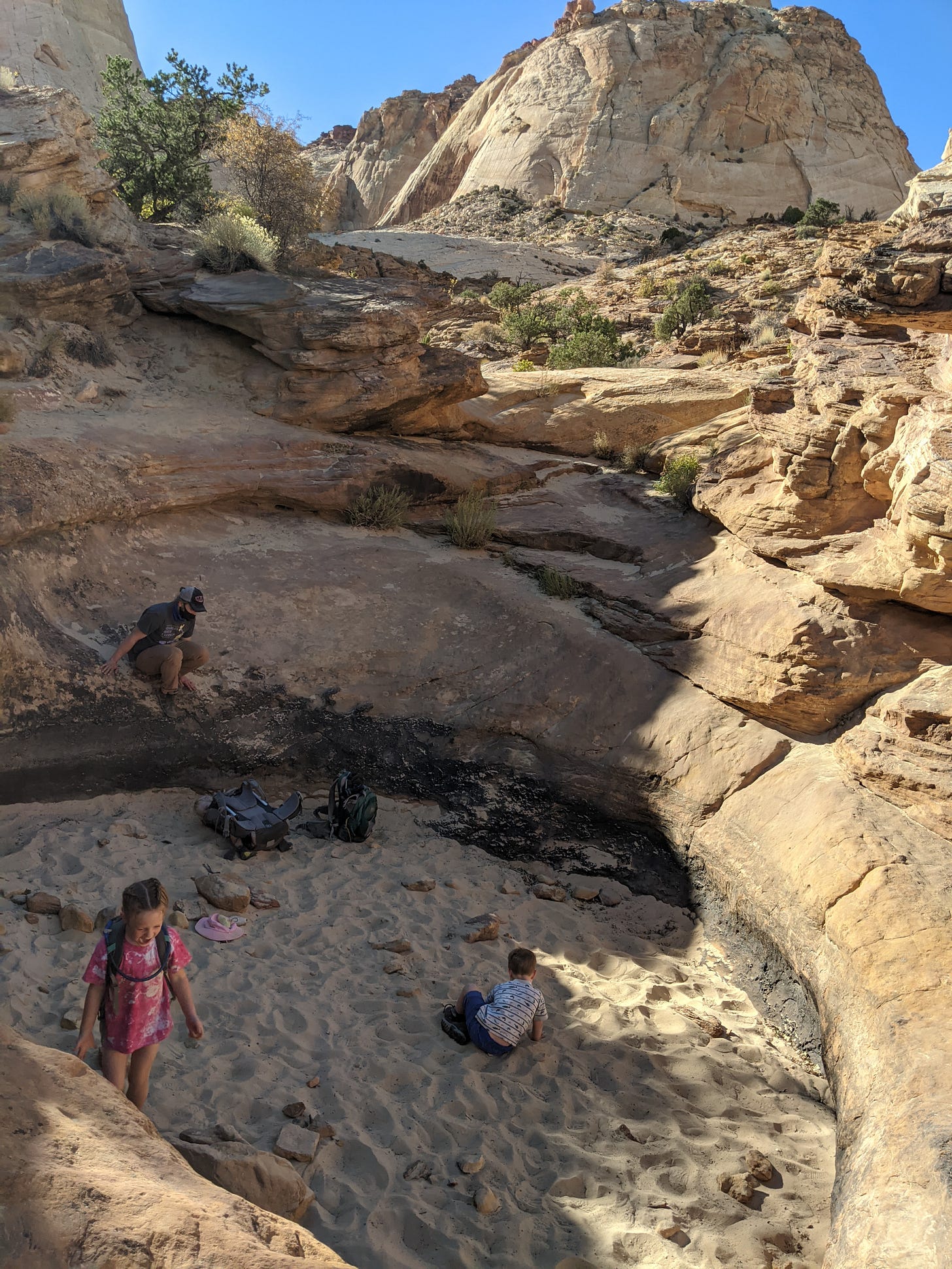
What Not to Pack
When we first started adventuring outdoors with our children, we were grossly overpacked. Here’s a list of what not to pack, created from mistakes I have made.
Food:
Avoid foods that require too much prep. You are not on History Channel’s “Alone” looking to pass the time and conserve calories in a square-mile radius for 89 days; you are a tourist. Burning hours of daylight and precious minutes of emotional stability before the pre-naptime meltdown makes no sense. The quicker it takes to make, the happier everyone will be.
Avoid too much junk food. A week into our trip, we were so deprived of greens, we all devoured a BAG of spinach in just a few minutes. When I went to a local grocery store, my daughter casually chimed from the back seat, “Could you just grab me some lettuce?”
Clothes:
Too many clothes. You can always stop at a laundromat, and there will be fewer socks to lose.
Not bringing Pull-Ups for toddlers. It may be a little extreme if your kids are already potty-trained, but nothing derails a camping trip like a urine-soaked sleeping bag. Call it “happy camper insurance underwear.”
Too much stuff in the tent. Bring in just what you need for the next day. I sleep with wet wipes in my sleeping bag so they are warm enough to not give my child frostbite on contact with his unsuspecting genitals in the morning. The kids either sleep with their clothes on for the next day or tucked inside their sleeping bags.
Things to Do:
Too many things. Extra books, crayons, toys just get strewn about and destroyed. Trust that nature is the ultimate entertainer and bring just a handful of items.
Annoying audiobooks. Our kids are addicted to stories on Audible, so we have an old, broken phone that plays Winnie-the-Pooh, Peter Pan, and The Penderwicks on repeat. Delete annoying stories off the phone before the trip, so it does not become an argument between your kids and your sanity. “I can’t download The Boxcar Children; there’s no internet. Boo, too bad.”
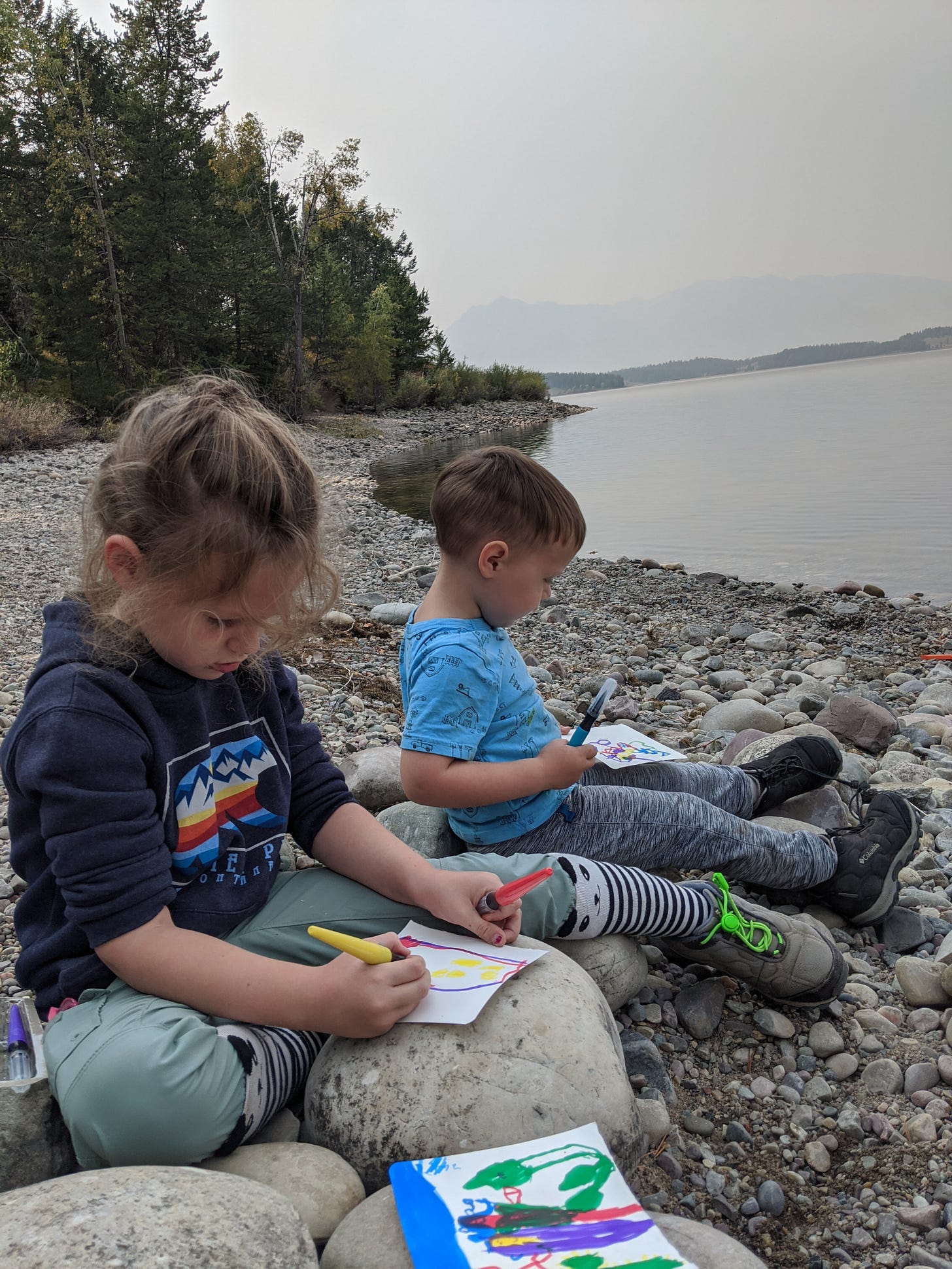
Research the Place You’re Visiting
I’m sure this goes without saying, but research where you’re going, the weather, and the wildlife surrounding the area. North Rim of the Grand Canyon was the coldest place we went on our trip. We were not prepared. I saved all the shorts and warm weather clothes for Arizona. Oops. I felt like the parent of the year when our poor son woke up in the middle of the night, crawled into my sleeping bag, and woke me up with his shivering. Search the forecast before leaving, so you aren’t stuck guessing the weather without cell phone reception as we did.
Canyonlands was breathtaking for us, but not in the way we expected. Our youngest, a two-year-old and an adrenaline junkie, kept breaking away towards 1,400-foot canyon drop-offs. No plan, no parachute. They say a pack of cigarettes takes away 28 minutes of your life. But did you know that an hour at the Canyonlands’s Grand View Trail takes away one year of your life?
If you are going to a place specifically to stargaze, check the lunar cycle to make sure you are going when it’s a new moon or close to it. We were excited to stargaze in Great Basin National Park on a clear night before realizing we went during the Harvest Moon. The moon was so bright, we were making shadow puppets on the ground.
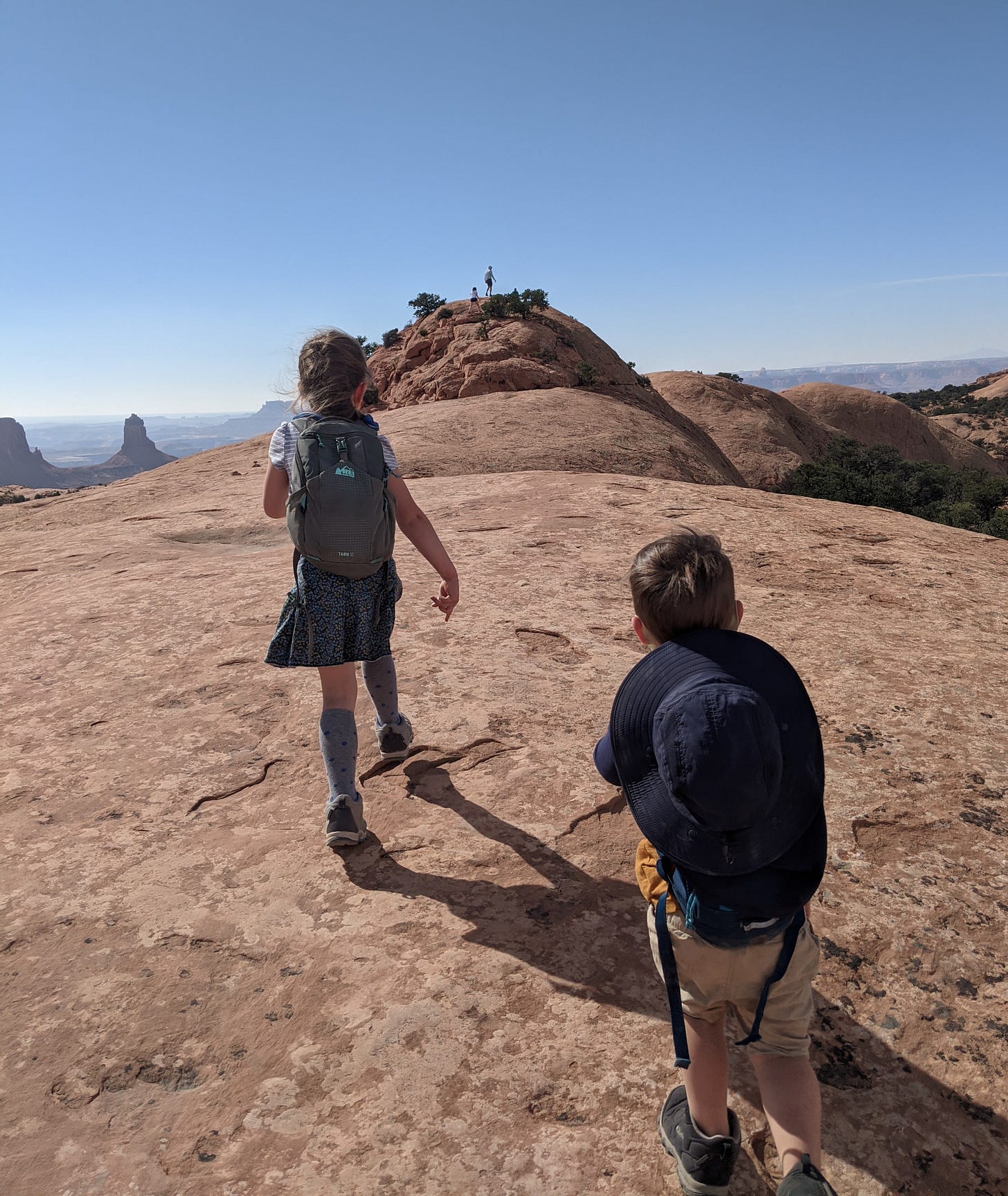
Camping
When we first started camping, we’d take hours and hours to prep meals, gather everything we needed, and load up the car. Then we’d drive hours, spend hours unloading our crap, make a mediocre meal, and fail to get a good night’s sleep on the hard ground with our screaming babies. In the morning, we’d reverse the order and go home, exhausted. I remember one time, trying to prepare a campfire meal while wrestling our kids away from the fire, my husband said, “This is not fun.” One of us almost died on that trip, and it wasn’t the kids or me.
Since those first experiences, I have camped while pregnant, nursing infants, and even once by myself for four days with three kids ages four and under. And now we love it. It may be because we are now more feral, but perhaps it’s because we have found what works for us.
We are not picky. And by picky, I mean we don’t need a campground that meets basic living standards, like a pit toilet. We decided this year that we’d much rather camp on Bureau of Land Management (BLM) land than a private campground. In addition to it being a safer option in the era of COVID, it is also free. We use the app The Dyrt to find good BLM camping areas. The app reviews sites to let you know if the area has cell phone reception, nearby amenities, attractions and shares pictures of what the area looks like.
Though camping on BLM land has worked well for us, it does not come without risks. BLM land cannot be reserved, so sometimes it takes a while to find something that works for you or isn’t already taken. The space you get varies. At Great Basin, we chose to camp next to an abandoned, dilapidated sheep pen (at first, I thought it would be cool to camp inside the pen, but then immediately changed course after seeing all of the poop). The land was flat, and we were the only ones for miles and miles. We could scream, run around, and change without anyone seeing us. And we did. It was liberating. When we went to Capitol Reef, we were on top of each other. One of our neighbors *actually* ran into a tree trying to squeeze out of their campsite. Another neighbor started watching “The Departed,” you know, that family-friendly movie perfect to watch in surround sound in a close-quartered tent at 8:30 PM? So, it’s a toss-up.
Another downside (depending on your attitude) to BLM camping is the lack of toilets. Personally, I now prefer plowing my own field to relieve myself in the glory of nature instead of going in a poorly ventilated, bug-ridden, overused pit toilet. To survive facility-less camping, some skills must be learned. Hand sanitizer and a trowel are must-haves. Gallons of water must be stored in your car, and children must learn how to go to the bathroom outside.
When we first moved to Utah from Boston, my children would cry about any tiny amount of water on their clothes and immediately change. I slowly taught them the mantra, “Things dry fast in Utah,” to persuade them not to increase the laundry burden threefold. This summer, when my daughter, trying to get the knack of peeing in the wilderness, peed all over herself, she shrugged, saying, “Things dry fast in Utah.” After about thirty failed attempts, our girl now has the peeing in the wild down. She’s missed so much kindergarten from our trips; I’m going to negotiate her peeing-in-the-wilderness-skill for a few common core standards. Our son, on the other hand, picked up peeing anywhere in the wild very quickly.
Structuring Time
A hard part of camping is how different it is from your normal routine. Creating a routine and talking about it often will help children feel in control and less a victim to wherever Mother Earth calls you.
Our daily schedule usually plays out something like this:
Hard (3+ miles)/popular hike in the morning
Lunch at a scenic place where the kids can play
Eat lunch, watercolor, play. Our kids have really taken to watercolor painting to decompress from the morning. We first did this at Jackson Lake at Grand Teton, and it was a huge hit.
Scenic drive while the kids nap or rest
Play in the afternoon
Something easy/fun for kids (i.e., catching crayfish and swimming in the Lamar River in Yellowstone, picking up pinecones on the Nature Trail at the North Rim of the Grand Canyon, wading in Lake McDonald at Glacier, skipping rocks at Schwabacher Landing at Grand Teton)
Return to campsite
Explore/dinner/hot chocolate
Bedtime for kids
Hot tea, stargazing, reading, bed
It can be tricky to get kids used to falling asleep outside. We try to make it as similar to their bedtime routine at home as possible. For us, that means we do our bedtime routine, and then our kids fall asleep listening to a story. When our youngest was a baby, we literally brought his porta-crib in the tent with a white noise machine (or me just shushing my baby’s face until I passed out). This is where the space you get on BLM land has its advantages. And after the first few days, the kids are so tired from hiking and playing outside all day; they fall right asleep. In the fall, when the temperatures drop at night, our kids almost beg to get in bed so they can be cozy and warm in their sleeping bags.
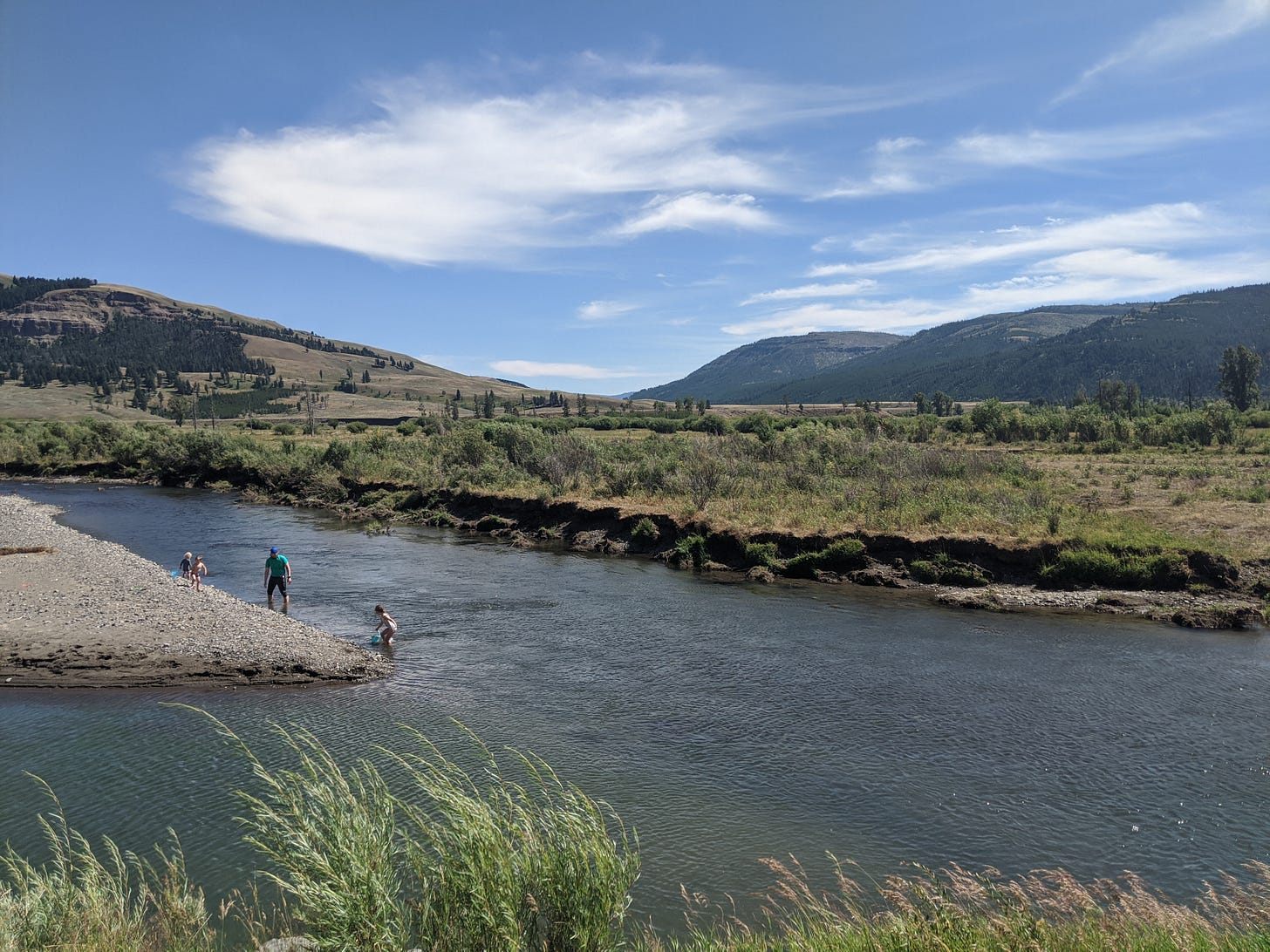
Hiking
If you have never heard of the app AllTrails, I highly recommend it. With the pro-version, you can download the trail maps, which was nice for us because we could honestly tell our children how much longer we all had to suffer before we got back to the trailhead on our long hikes. With AllTrails, look for popular, highly rated hikes, but I would argue that the lightly trafficked trails are the best for kids. On most of these trails, we didn’t get great views, but we could see some amazing wildlife (bighorn sheep, black bears, deer, moose, beavers, snakes, etc.). We have learned that our kids could care less about views and more about a stagnant, stinky pond they can throw rocks in. On other trails, we were able to find geodes that would have been impossible to find on highly trafficked trails. There is some magic in the seemingly mediocre.
If you are insistent on doing popular, long hikes (we were a few times), let the kids pick which ones to give them a chance to make decisions. Do these hikes in the morning while everyone is still in a good mood. Putting our youngest in the carrier first thing helped with our pacing, but not with the screaming. On the upside, that also meant we didn’t need to buy a bear bell because, well, screaming.
Once you’ve picked your hike for the morning, the battle will be keeping up morale during the hike.
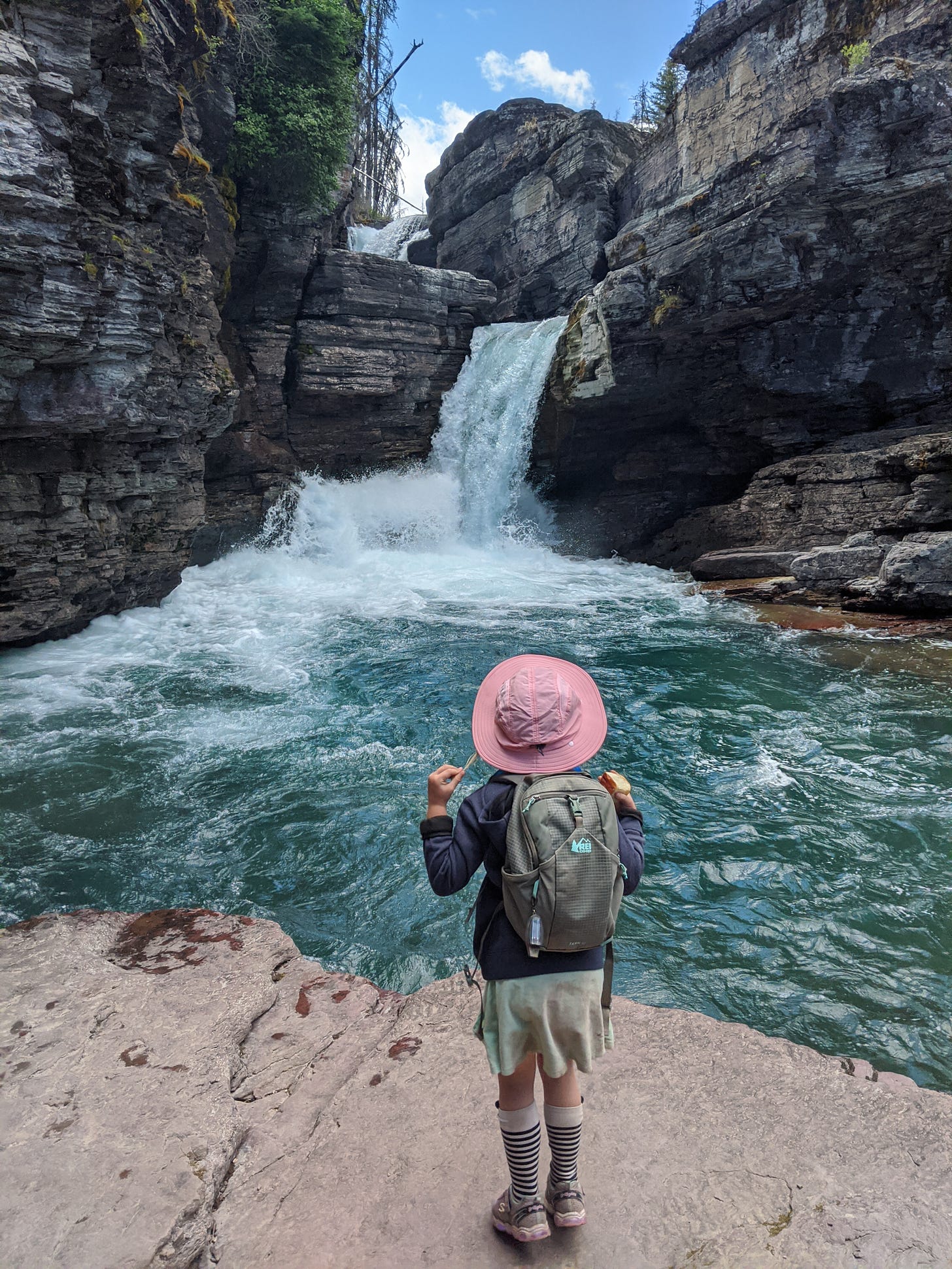
Keeping Your Sanity While Hiking
Storytelling. Our kids love hearing stories about themselves as babies. I have told the same dumb story about my kids messing up their room during one frustrating naptime three years ago more times than I can count, and they still think it hilarious. I recently read the book, How to Tell Stories to Children by Joseph Sarosy and Silke Rose West, and I cannot recommend it enough. I started making up stories about my kids and nature around us (rocks, waterfalls, trees, etc.). It has made hiking so much more pleasant. When I finish the story, my daughter happily skips ahead, busy retelling her own version.
Rorschach test. Sometimes my husband and I just point at things and say, “What does that look like?” We do this with clouds, tree shapes, and rocks. This was especially effective at Bryce Canyon with the hoodoos. You can also use this as a litmus test for your child’s mood. If they say, “That hoodoo looks like a birthday candle,” you still have at least another thirty minutes of good spirits. If your child points to a hoodoo and says, “That looks like a body about to fall down and die,” you should start making plans to carry them.
I spy. I will warn you, the colors are pretty limited in nature (especially at Arches). This works for a few minutes, but it’s not going to last the whole hike.
Rock surfing. Jump from rock to rock and pretend to surf. You look a little weird, but it’s great balancing practice for kids and gets them thinking about a tangible challenge instead of an abstract hike.
Searching for wildlife or plants. On the Appalachian Trail in Maine, my kids got very busy searching the trail for mushrooms and frogs. We brought collapsible buckets on a trail at Glacier National Park, and they picked huckleberries and thimbleberries as we hiked.
Girls Camp songs. Songs I have had to dust off the old mental shelf that I thought/hoped I would never use again have saved us.
Have a goal. If you are hiking to a waterfall, tell the kids to keep their eyes out for the waterfall. Or look and listen for clues indicating you are getting close.
Turn around whenever. You are the trail master. Little kids don’t care too much about getting to that viewpoint; you do.
A word of caution: don’t over-hike your children. Glacier National Park was one of the most beautiful places we have ever been to. My husband and I wanted to see it all. So we hiked twenty miles in three days, and our kids nearly committed mutiny. They refused to go on any hikes in Yellowstone, and after our trip, anytime we got in the car for the next two weeks, our kids asked us suspiciously, “We’re not going hiking, are we?” We had to teach them to fall in love with hiking all over again by choosing short hikes with huge payoffs (insert plug for Sand Dune Arch at Arches National Park here).
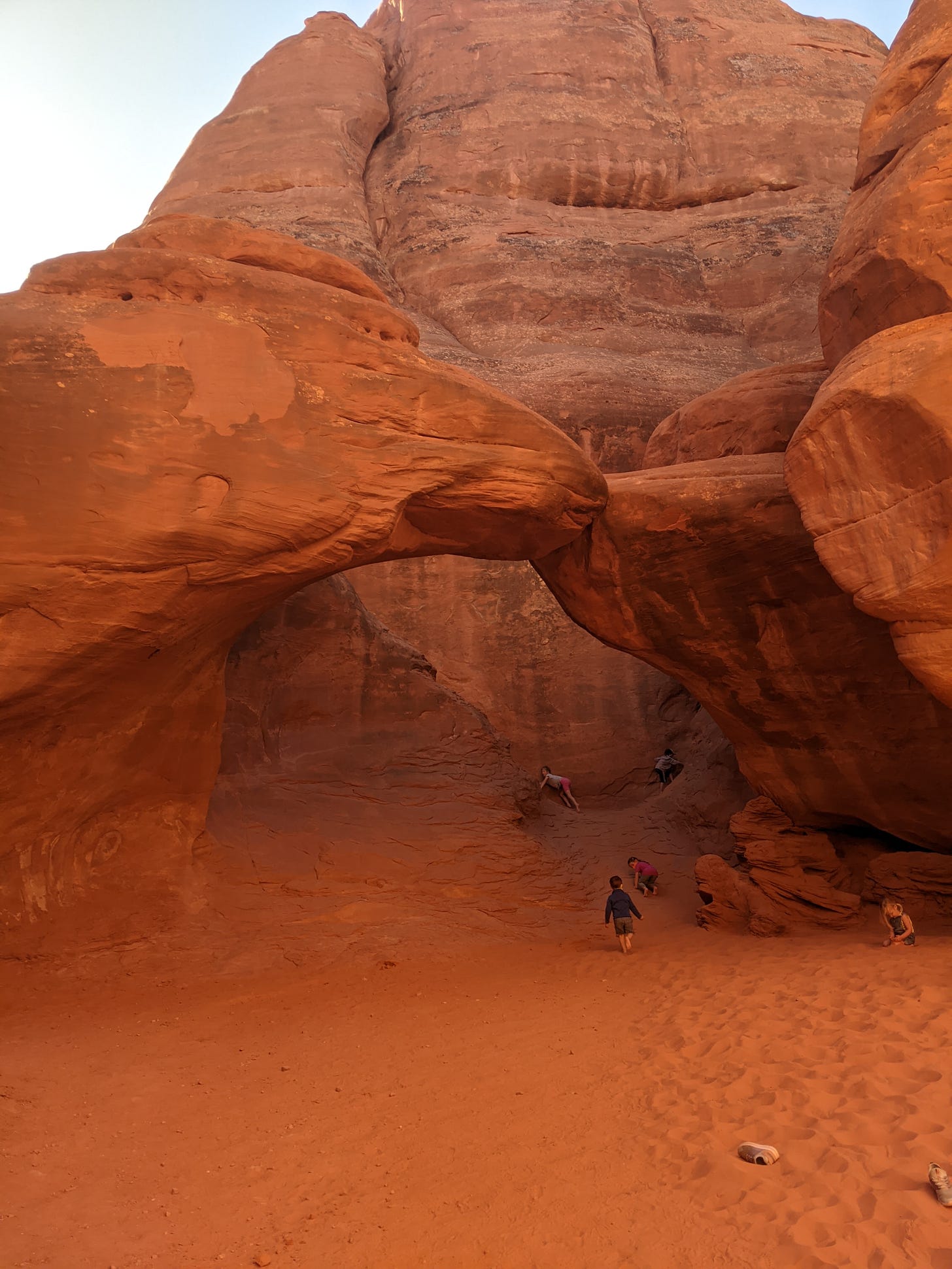
Final Takes
There is a learning curve to becoming an outdoorsy family. And it seems like every spring; it takes a trip or two to get back into the groove. You can do it! All that is necessary is the desire. Start with eating outside, taking short walks, then move to local hikes and an overnight outside. Focus on the experience and not the checklists. By being outside with your family, you have already met your goal!
I love being outside with my kids because it’s one of the few times I am not tempted to clean up the house, get side-tracked by my to-do list, or get caught doomsday scrolling on my phone for hours. I get to hear things like, “I wish I could pee outside every day!” Or my two-year-old stringing together the words, “I hiking!” amongst his babble. I hear my children beg, “Can we stay at this waterfall forever?” In nature, we experience wonder together. We witness our children learning from the greatest teacher and falling in love with it. It is a messy, primitive, Elijah-inspired, heart-turning privilege. Learning to love the outdoors as a family was a battle worth fighting for. It is now a re-calibrator for us, something we can do together to momentarily set down the burdens of society and gain clarity and peace. I hope it will be that way for you too.






Beautiful - thank you for sharing. There is something about family camping memories that bind us together. My family's 1979 backpacking trip in the Tetons, including holding a church service on Sunday and glissading down a large snowfield, still supports me today.